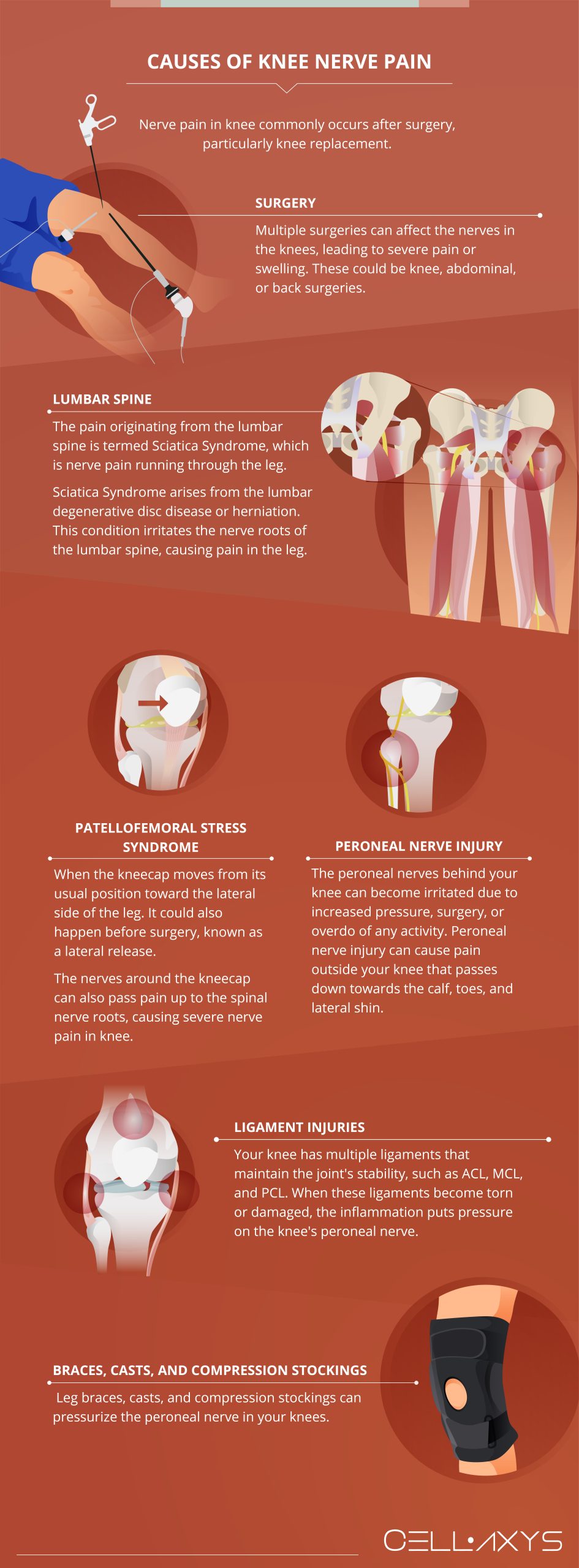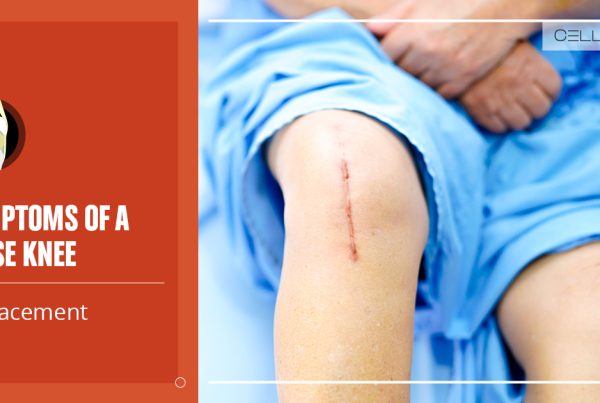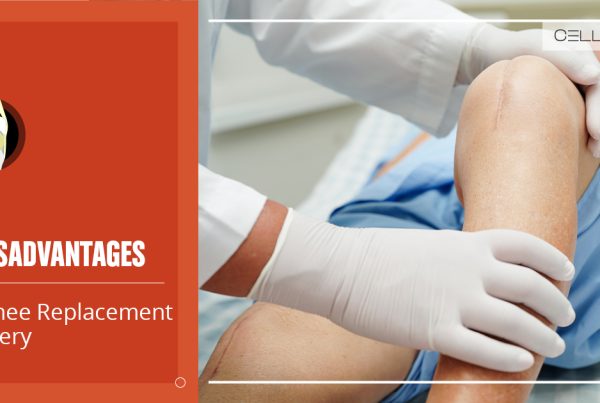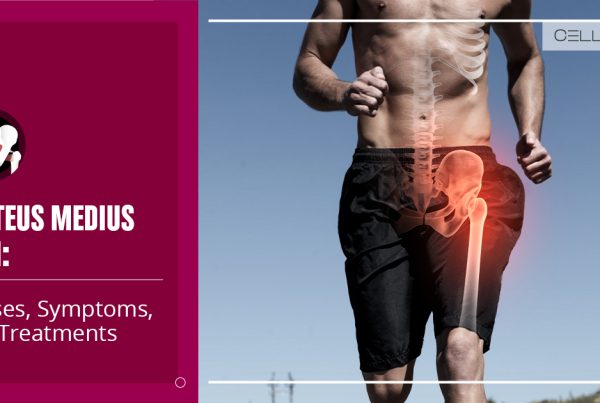Published on: September 9, 2022 | Updated on: January 18, 2025
Nerve pain in the knee can restrict a person from performing everyday activities. The pain is identified with numbing and tingling sensations in the knees. If left untreated, the knee nerve pain can become a nuisance and life-altering.
Nerve pain in the knee usually occurs in the lumbar spine, small nerves of the knee, and the pelvis. Many people experience severe knee pain after surgery due to incisions. Others can have nerve pain due to knee arthritis or ligament injuries.
Initial knee nerve pain treatment includes OTC anti-inflammatory medications, steroid injections, icing, and physical therapy. If the pain persists, your healthcare provider may recommend surgery or an orthobiologic method, such as cell-based therapy or platelet-rich plasma (PRP) therapy.
What is Nerve Pain in Knees?
Nerve pain is a burning, numbing, or tingling sensation in the knees. The knee has the peroneal nerve, which extends from the sciatic nerves. The sciatic nerves run through each leg from the lower back.
When you have nerve pain in your knee, it can cause multiple symptoms that may affect your entire leg. Some common signs of knee nerve pain include:
- Tingling that feels like needles
- Pain
- Numbness
- Burning sensation
- Difficulty lifting toes
- Struggles in walking
People with arthritis can experience severe symptoms, such as:
- Swelling
- Clicking and grinding sensations
- Popping sensations
- Ligament injuries
- Meniscus tears
Causes of Knee Nerve Pain
Nerve pain in knee commonly occurs after surgery, particularly knee replacement. In this procedure, your healthcare provider stretches the outside nerves of the affected knee. It could result in weakness in the ankle, also known as “foot drop.”
Apart from peroneal and sciatic nerves, multiple sensory nerves run inside and outside your knees. During surgery, these nerves can get irritated by knee braces, pressure, or incisions. Bow-legged knees can also stretch these nerves, causing pain.
Some common causes of knee nerve pain are:
Surgery
Multiple surgeries can affect the nerves in the knees, leading to severe pain or swelling. These could be knee, abdominal, or back surgeries.
Lumbar Spine
A lumbar spine segment comprises two consecutive vertebrae (L4-L5), intervertebral discs, facet joints, and spinal nerves. The pain originating from the lumbar spine is termed Sciatica Syndrome, which is nerve pain running through the leg.
Sciatica Syndrome arises from the lumbar degenerative disc disease or herniation. This condition irritates the lumbar spine’s nerve roots, causing leg pain.
The lumbar spinal nerves are numbered from 1 to 5. These nerves provide different sensations (including pain) and information to their designated areas.
For example, L2 nerve root irritation goes to the inner thigh and groin. L3 provides painful sensations to the anterior thigh, and pain in L4 goes to the medial and front areas of the knee toward the kneecap.
Patellofemoral Stress Syndrome
Patellofemoral stress syndrome is when the kneecap moves from its usual position toward the lateral side of the leg. It could also happen before surgery, known as a lateral release. In this condition, the kneecap comes under pressure and pain.
The nerves around the kneecap can also pass pain up to the spinal nerve roots, causing severe nerve pain in the knee.
Peroneal Nerve Injury
The peroneal nerves behind your knee can become irritated due to increased pressure, surgery, or overdoing any activity. Peroneal nerve injury can cause pain outside your knee that passes down towards the calf, toes, and lateral shin.
Ligament Injuries
Your knee has multiple ligaments that maintain the joint’s stability, such as ACL, MCL, and PCL. When these ligaments become torn or damaged, the inflammation puts pressure on the knee’s peroneal nerve. As a result, you feel severe nerve pain in your knee.
Braces, Casts, and Compression Stockings
Many things can compress the nerves outside your knee and cause severe pain. Leg braces, casts, and compression stockings can pressurize the peroneal nerve in your knees.
Treatment for Nerve Pain in Knee
Treating your knee nerve issue depends on the intensity of the pain. However, several causes of nerve pain can be easily treated through lifestyle changes and orthobiologic methods.
Initial Treatment
The treatment for nerve pain caused by pinched nerves is focused on relieving the pressure. The initial treatment methods recommended for knee nerve pain include:
- OTC Anti-Inflammatory Medications. Your healthcare provider usually suggests a few OTC non-steroidal anti-inflammatory drugs (NSAIDs) to relieve the swelling and compression of the nerves. These include naproxen and Ibuprofen.
-
- Steroid Injections. Your doctor may also give you corticosteroid injections to reduce inflammation and knee pain.
- Icing. You can also apply ice to the inflammation near your knees.
- Avoid Physically Demanding Activities. Many activities can compress the peroneal nerve in your knee, such as squatting, frequently crossing legs, and wearing high-knee boots and compression garments. Avoid doing these activities.
- Physical Therapy. Your physical therapist would suggest you straighten your knee, leg, and back to relieve nerve pressure in the knee.
- Orthopedic Devices. Your doctor may recommend wearing support devices to move smoothly.
Orthobiologic Methods
If the nerve pain in the knee persists, orthobiologic procedures are the best treatments. Cell-based therapy and platelet-rich plasma therapy (PRP) are popular orthobiologic methods that replace your damaged tissues with newer ones.
- Cell-based Therapy. After diagnosing your knee condition, your doctor will go for one of the two types of cell-based therapy: Minimally Manipulated Adipose Tissue Transplant (MMAT) and Bone Marrow Concentrate (BMAC). MMAT includes transplanting your inflamed adipose tissues, while BMAC involves replacing the damaged bone marrow cells with healthy ones.
- Platelet-rich Plasma (PRP) Therapy. Platelet-Rich Plasma (PRP) therapy stimulates the growth of healthy tissues in your body. The human body needs platelets to produce fibrin, a sticky web promoting tissue development. Platelets also enhance the healing process.
Cell-based or stem cell therapy is completed within 1.5-2 hours, while PRP therapy takes 45 minutes. After the treatment, your doctor will probably send you home within a few hours.
What is the Recovery Time for Knee Nerve Pain Treatment?
The recovery duration for your knee pain may differ depending on the intensity. The healing period for common knee injuries is 4 to 12 weeks. You can shorten your recovery time with prompt treatment and prevention.
Sources
Footnotes
- Heidari B. Knee osteoarthritis prevalence, risk factors, pathogenesis and features: Part I. Caspian journal of internal medicine. 2011;2(2):205.
- Ito H, Tominari S, Tabara Y, Nakayama T, Furu M, Kawata T, Azukizawa M, Setoh K, Kawaguchi T, Matsuda F, Matsuda S. Low back pain precedes the development of new knee pain in the elderly population; a novel predictive score from a longitudinal cohort study. Arthritis Research & Therapy. 2019;21:1-9.
- Kamel SR, Ibrahim RS, Moens HM, Mohammed RM. Neuropathic pain in primary knee osteoarthritis patients: correlation with physical function, quality of life, disease severity, and serum beta nerve growth factor levels. Egyptian Rheumatology and Rehabilitation. 2021;48(1):1-9.
- Fernandes GS, Valdes AM, Walsh DA, Zhang W, Doherty M. Neuropathic-like knee pain and associated risk factors: a cross-sectional study in a UK community sample. Arthritis Research & Therapy. 2018;20(1):1-1.
- Waryasz GR, McDermott AY. Patellofemoral pain syndrome (PFPS): a systematic review of anatomy and potential risk factors. Dynamic Medicine. 2008;7(1):1-4.
- Lezak B, Massel DH, Varacallo M. Peroneal Nerve Injury. [Updated 2022 Nov 14]. In: StatPearls [Internet]. Treasure Island (FL): StatPearls Publishing; 2023 Jan.
- Dhalla IA, Gomes T, Mamdani MM, Juurlink DN. Opioids versus nonsteroidal anti-inflammatory drugs in noncancer pain. Canadian Family Physician. 2012;58(1):30.
- Vieira Ramos G, Pinheiro CM, Messa SP, Delfino GB, Marqueti Rde C, Salvini Tde F, Durigan JL. Cryotherapy Reduces Inflammatory Response Without Altering Muscle Regeneration Process and Extracellular Matrix Remodeling of Rat Muscle. Scientific Reports. 2016;6:18525.
References
- What Causes a Pinched Nerve in the Knee and How to Treat It. Healthline. Accessed 9/6/2023.
- Does Sciatica Cause Knee Pain?. Spine-Health. Accessed 9/6/2023.
- Knee Neuropathies. American Academy of Physical Medicine and Rehabilitation. Accessed 9/6/2023.
CELLAXYS does not offer Stem Cell Therapy as a cure for any medical condition. No statements or treatments presented by Cellaxys have been evaluated or approved by the Food and Drug Administration (FDA). This site contains no medical advice. All statements and opinions are provided for educational and informational purposes only.
Dr Pejman Bady
Author
Dr. Pejman Bady began his career over 20 years ago in Family/Emergency Medicine, working in fast-paced emergency departments in Nevada and Kansas. He has served the people of Las Vegas as a physician for over two decades. Throughout this time, he has been met with much acclaim and is now the head of Emergency Medical Services in Nye County, Nevada. More about the doctor on this page.
Dr Pouya Mohajer
Contributor
Pouya Mohajer, M.D. is the Director of Spine and Interventional Medicine for CELLAXYS: Age, Regenerative, and Interventional Medicine Centers. He has over 20 years of experience in pain management, perioperative medicine, and anesthesiology. Dr. Mohajer founded and is the Medical Director of Southern Nevada Pain Specialists and PRIMMED Clinics. He has dedicated his career to surgical innovation and scientific advancement. More about the doctor on this page.










